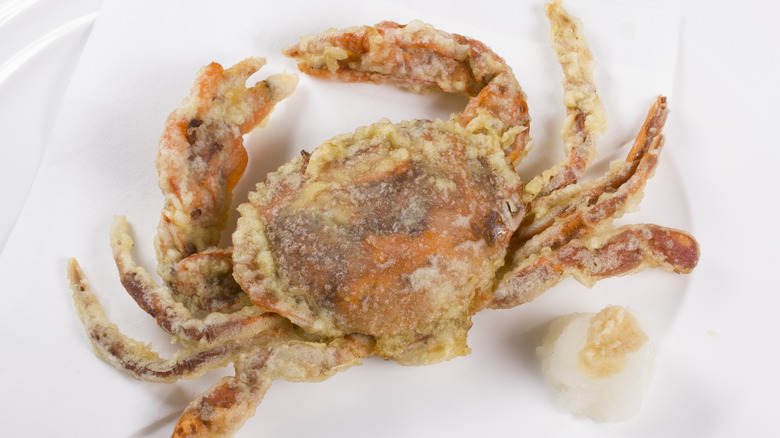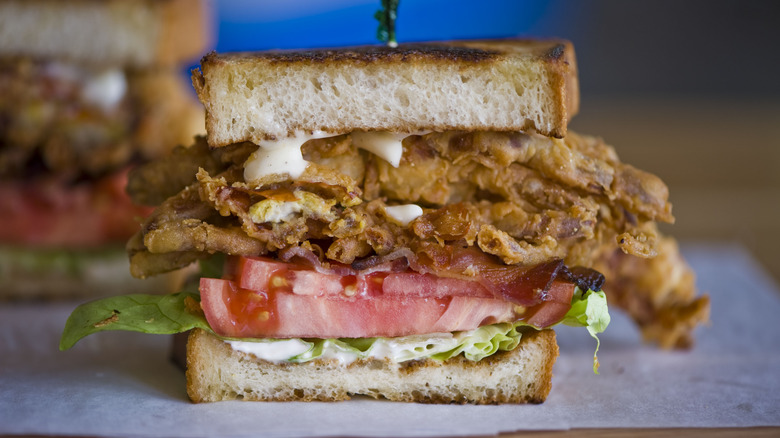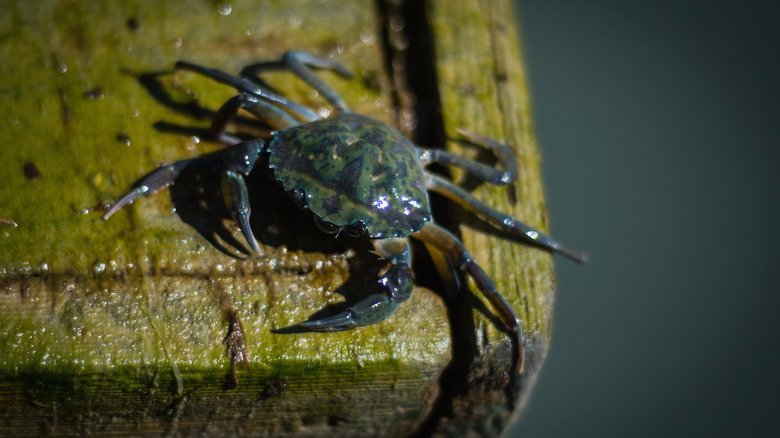Can You Really Eat A Whole Soft-Shell Crab, Shell And All?
Everyone has their favorite signs of spring, from the first robin in the yard to the first daffodil blooming in the garden. Chefs like Eric Ripert, however, know it's truly spring when the first soft-shell crabs show up in the fish market. Seafood lovers know to mark their calendars for soft-shell season to start — which is usually sometime in March — because you can make all kinds of crabby dishes and delicacies without all the fuss of cracking any shells.
Often referred to affectionately as "softies," soft-shell crabs are just regular crabs (often blue crabs) that are going through a natural growth stage in the spring and summer. When the ocean water temperature starts to warm up, crabs will naturally start to molt and shed their hard shells as their bodies get bigger. For a short time after they emerge from their former shells, the outside of the crab is more like a skin, which means you can eat pretty much the entire thing. With just a little bit of prep, you can pop a whole crab into a sauté pan to get it golden brown, and then munch on the whole crispy critter.
Why are crabs soft?
For the majority of their lives crabs have hard shells, which keeps the tissue inside safe from the elements and predators. Crabs are always growing, however, while their shells stay the same size, so periodically they have to shed the old shells when they run out of space. When the ocean water temperature reaches around 65 to 70 degrees Fahrenheit, the conditions are right for the molting, which is actually called "ecdysis."
According to the Chesapeake Bay Program, warmer temperatures trigger the crab to start detaching from its shell. As this is happening, the shell starts dissolving and thinning. Eventually the old shell cracks open and the naked crab comes out, which is when they're harvested. They don't stay that way for long, though; soft-shell crabs are only soft for around two or three hours before their shells start hardening again, which historically made them very difficult to capture at just the right moment. Thus a delicacy was born. Nowadays fishermen are trained to know the signs of when the crabs are going to shed their shells, so they harvest them a few days before they molt and hold them in tanks with the proper temperature to catch them at peak softness. Always make sure your crabs are alive and intact with all their legs and claws attached when you buy them unless they're sold frozen, because dead crabs deteriorate very quickly.
How to eat soft-shell crabs
Softies are almost entirely edible including the claws, legs and bodies. All you need to do to prepare a soft-shell crab for cooking is to remove a few key parts: the face, lungs, and the abdominal flap. The best tool for this job is a pair of sharp kitchen shears so that you can make controlled cuts. The first cut should be the face of the crab, which kills it instantly. To remove the lungs, pull up the soft top shell on the left and right of the crab to expose the spongy tissue and snip them away. Finally, flip the crab over and pull the distinct flap down from the center of the body, which is also known as the apron, and snip it away at the base. You can also remove the yellow-y paste near the head, which is the tomalley, but this is totally optional.
Soft-shell crabs are best when they're cooked to be crunchy, so try sautéing them in oil, or dredging them in cornmeal or flour and frying them as either an appetizer or served on a bun for a crispy seafood sandwich. They're also a sushi staple, and are delicious cooked in a bit of tempura batter. Whatever recipe you choose, don't wait to try it — soft-shell season is over when temperatures cool down in the fall, so get 'em while you can.


